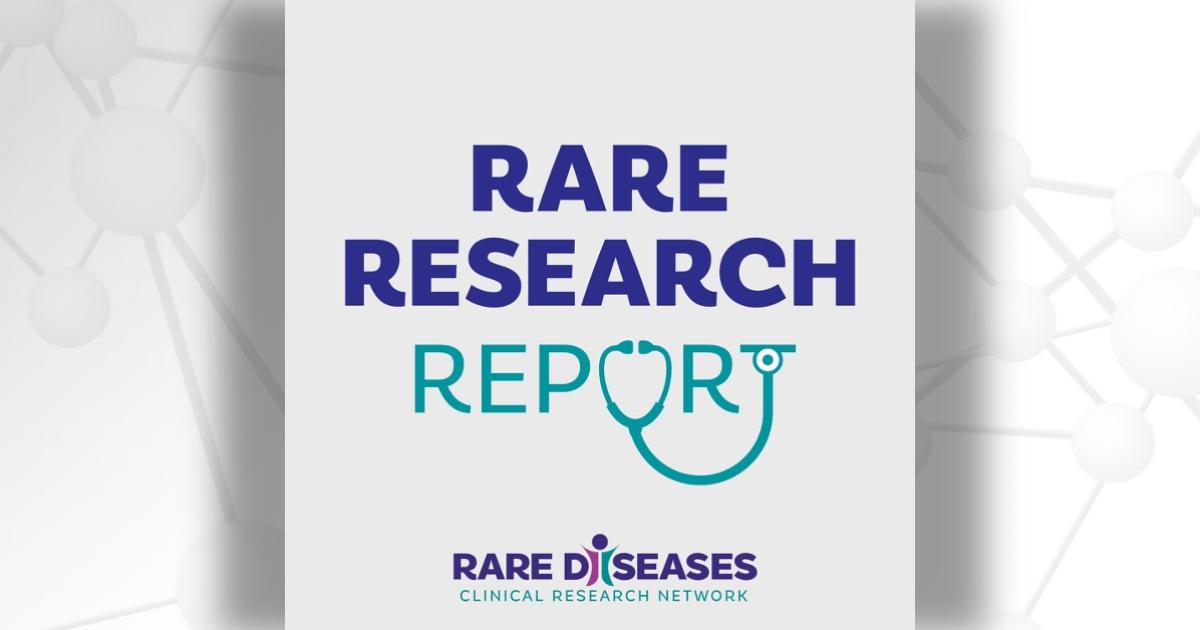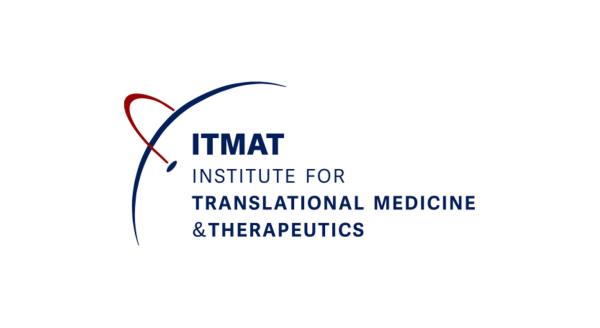Each month, we share summaries of recent Rare Diseases Clinical Research Network (RDCRN) grant-funded publications. Catch up on the latest RDCRN research below.
Jump to:
- Brain Vascular Malformation Consortium (BVMC)
- Consortium of Eosinophilic Gastrointestinal Disease Researchers (CEGIR)
- Frontiers in Congenital Disorders of Glycosylation Consortium (FCDGC)
- Global Leukodystrophy Initiative Clinical Trials Network (GLIA-CTN)
- Myasthenia Gravis Rare Disease Network (MGNet)
- Porphyrias Consortium (PC)
Listen to these summaries on the Rare Research Report podcast.
Brain Vascular Malformation Consortium (BVMC)
Determining Current Rescreening Practices for Brain and Lung Arteriovenous Malformations in Children and Adults with Hereditary Hemorrhagic Telangiectasia
Hereditary hemorrhagic telangiectasia (HHT) is an inherited disorder of the blood vessels that can cause excessive bleeding. Patients with HHT are at risk for organ vascular malformations, including arteriovenous malformations (AVMs) in the brain and lungs. Although HHT guidelines recommend initial screening in children and adults, rescreening is not consistently addressed.
In this study, researchers determined current rescreening practices for brain and lung AVMs in children and adults with HHT. The team surveyed 30 North American HHT Centers of Excellence on rescreening practices for new brain and lung AVMs in patients with initial negative screening.
Results show that most HHT Centers of Excellence routinely rescreen children for brain and lung AVMs and adults for lung AVMs when initial screening is negative. However, adults are infrequently rescreened for brain AVMs. Authors note that long-term data regarding risk for new brain and lung AVMs are required to establish practice guidelines for rescreening.
Beslow LA, Kim H, Hetts SW, Ratjen F, Clancy MS, Gossage JR, Faughnan ME. Brain and lung arteriovenous malformation rescreening practices for children and adults with hereditary hemorrhagic telangiectasia. Orphanet J Rare Dis. 2024 Nov 9;19(1):421. doi: 10.1186/s13023-024-03402-8. PMID: 39522006; PMCID: PMC11549847.
Consortium of Eosinophilic Gastrointestinal Disease Researchers (CEGIR)
Comparing Parent and Child Patient-Reported Outcomes in Eosinophilic Esophagitis Over Time
Eosinophilic esophagitis (EoE) is a disorder in which eosinophils (white blood cells of the immune system) build up in the esophagus, causing tissue damage. Symptoms include difficulty swallowing, food getting stuck in the throat, vomiting, reflux, malnourishment, and poor appetite. Because young children are unable to report their own symptoms, parents must report on the child’s behalf. However, not much is known about the long-term alignment of symptoms reported by parents and child patients.
In this study, researchers compared parent and child patient-reported outcomes in EoE over time. A total of 292 parent-child respondents completed 723 questionnaires about symptoms over a 5-year period, which researchers used to track long-term changes and similarities in reported outcomes.
Results show that there is strong long-term alignment between parent and child patient-reported outcomes. Authors note that these findings provide evidence that parent-report by proxy is an accurate means to monitor symptoms, which provides a framework for monitoring pediatric patients in clinical trials.
Martin LJ, Zhang X, Chehade M, Davis CM, Dellon ES, Falk GW, Gupta SK, Hirano I, Hiremath GS, Katzka DA, Khoury P, Leung J, Menard-Katcher P, Gonsalves N, Pesek RD, Spergel JM, Wechsler JB, Kliewer K, Arva NC, Collins MH, Pletneva M, Yang GY, Furuta GT, Rothenberg ME, Aceves SS. Long-term durability between parent and child patient-reported outcomes in eosinophilic esophagitis. J Allergy Clin Immunol. 2024 Nov;154(5):1232-1240.e12. doi: 10.1016/j.jaci.2024.07.011. Epub 2024 Jul 25. PMID: 39059504.
Frontiers in Congenital Disorders of Glycosylation Consortium (FCDGC)
Evaluating the Use of RNA Sequencing to Clarify Variants of Uncertain Significance in a Clinical Setting
RNA sequencing (RNA-seq) is a technique used to evaluate the sequence and quantity of messenger RNA, which can provide insights on gene expression. Although RNA-seq can help identify pathogenic variants in individuals with suspected genetic conditions, technological complexities and limited experience might affect its use in clinical practice.
In this study, researchers evaluated the use of RNA-seq to clarify variants of uncertain significance (VUS) in a clinical setting. The team developed a process to identify individuals who might benefit from clinical RNA-seq. Over a two-year period, genetics providers referred 26 cases for clinical RNA-seq, of which nine cases met the criteria for sequencing.
Results show that clinical RNA-seq was useful in clarifying uncertain results in about one-third of cases, including a new diagnosis of NGLY1 congenital disorder of deglycosylation. Authors note that demonstrating the clinical utility of RNA-seq may improve access to this new testing technique.
Marquez J, Cech JN, Paschal CR, Dingmann B, Scott AI, Thies JM, Mills MR, Albert CM, Beck AE, Beckman E, Bonkowski ES, Earl DL, Lam CT, Mefford HC, Merritt JL 2nd, Nelson Z, Ohlsen TJ, Taylor MR, Perlman SJ, Rudzinski ER, Sikes MC, Waligorski N, Wenger TL, Adam MP, Mirzaa GM, Bennett JT, Glass IA, Sternen DL, Miller DE. Clinical RNA sequencing clarifies variants of uncertain significance identified by prior testing. Genet Med Open. 2024;2:101886. doi: 10.1016/j.gimo.2024.101886. Epub 2024 Aug 9. PMID: 39484203; PMCID: PMC11526042.
Global Leukodystrophy Initiative Clinical Trials Network (GLIA-CTN)
Characterizing Family Perspectives to Define Health Concepts in β-Propeller Protein–Associated Neurodegeneration
β-propeller protein–associated neurodegeneration (BPAN) is a progressive, neurodegenerative disease characterized by buildup of iron in the brain, leading to severe neurologic impairments. Future clinical trials are anticipated to identify new therapies for BPAN.
In this natural history study, researchers characterized family perspectives to define health concepts in BPAN. Among 42 caregivers of children diagnosed with BPAN, the team administered the Vineland Adaptive Behavior Scales, Third Edition—a tool which supports diagnosis of intellectual and developmental disabilities—along with health-related quality of life questionnaires.
Results highlight the effects of BPAN on both patient and caregiver quality of life. Key health concepts identified by families included overall health, comfort, and communication. Authors note that these health concepts will help inform future clinical outcome assessments.
Kotes E, Gavazzi F, Woidill S, Sevagamoorthy A, Yang E, Smith V, Dubbs H, Pierce SR, Pucci K, Vithayathil J, Thakur N, Adang LA. Determination of Health Concepts in β-Propeller Protein-Associated Neurodegeneration. J Child Neurol. 2024 Oct 8:8830738241283932. doi: 10.1177/08830738241283932. Epub ahead of print. PMID: 39376195.
Myasthenia Gravis Rare Disease Network (MGNet)
Proposing an Artificial Intelligence-Powered Telemedicine Tool for Automatic Scoring of Neuromuscular Examinations in Patients with Myasthenia Gravis
Myasthenia gravis (MG) is a neuromuscular disorder caused by an autoimmune response which blocks or damages acetylcholine receptors in muscles. Telemedicine is now being used more frequently to evaluate patients with MG. During these remote visits, symptoms are evaluated using the Myasthenia Gravis Core Exam (MG-CE) and Myasthenia Gravis Activities of Daily Living (MG-ADL) assessments. However, human subjectivity can limit the reliability of these examinations.
In this study, researchers propose an artificial intelligence-powered telemedicine tool for automatic scoring of neuromuscular examinations in patients with MG. The team used computer vision, deep learning, and natural language processing methods to automate a standard telemedicine video by segmenting it into clips corresponding with the MG-CE assessment.
Results show that this AI-powered solution improves scoring efficiency and quality in neuromuscular assessments. Authors note that the tool could potentially enhance patient participation in clinical trials for MG and other neurological diseases.
Lesport Q, Palmie D, Öztosun G, Kaminski HJ, Garbey M. AI-Powered Telemedicine for Automatic Scoring of Neuromuscular Examinations. Bioengineering (Basel). 2024 Sep 20;11(9):942. doi: 10.3390/bioengineering11090942. PMID: 39329684; PMCID: PMC11429301.
Porphyrias Consortium (PC)
Developing a Wearable Light Dosimeter to Improve Quality of Life in Patients with Erythropoietic Protoporphyria
Erythropoietic protoporphyria (EPP) is a metabolic disorder characterized by the buildup of protoporphyrin, which is a light-sensitive substance. Individuals with EPP often experience severe pain from light exposure.
In this study, researchers developed a wearable light dosimeter both to improve quality of life in patients with EPP and to capture light exposure data for future EPP clinical trials. The dosimeters work by continuously capturing light doses of UVA, blue, and red wavelengths. The team tested the devices among five individuals with EPP, each wearing two light dosimeters—one as a watch, and one as a shirt clip—for three weeks.
Results show that wearable blue light dosimetry worn as a wristband is a promising method for measuring light exposure, as well as predicting and preventing symptoms in EPP.
Dickey AK, Berkovich J, Leaf RK, Jiang PY, Lopez-Galmiche G, Rebeiz L, Wheeden K, Kochevar I, Savage W, Zhao S, Campisi E, Heo SY, Trueb J, LaRochelle EPM, Rogers J, Banks A, Chang JK. Observational pilot study of multi-wavelength wearable light dosimetry for erythropoietic protoporphyria. Int J Dermatol. 2024 Nov;63(11):1584-1591. doi: 10.1111/ijd.17166. Epub 2024 Apr 11. PMID: 38602089; PMCID: PMC11467130.
The Rare Diseases Clinical Research Network (RDCRN) is funded by the National Institutes of Health (NIH) and led by the National Center for Advancing Translational Sciences (NCATS) through its Division of Rare Diseases Research Innovation (DRDRI). Now in its fourth five-year funding cycle, RDCRN is a partnership with funding and programmatic support provided by Institutes, Centers, and Offices across NIH, including the National Institute of Neurological Disorders and Stroke, the National Institute of Allergy and Infectious Diseases, the National Institute of Diabetes and Digestive and Kidney Diseases, the Eunice Kennedy Shriver National Institute of Child Health and Human Development, the National Institute of Arthritis and Musculoskeletal and Skin Diseases, the National Heart, Lung, and Blood Institute, the National Institute of Dental and Craniofacial Research, the National Institute of Mental Health, and the Office of Dietary Supplements.








